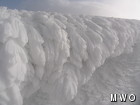Relative Humidity
2008-03-17 14:20:49.000 – Steve Welsh, IT Observer
Rime Ice
One of the things you notice whilst living on the top of Mount Washington in winter is how dry the air is. Over the course of a week long shift up here your skin dries out and cracks. Typically the air inside the building, at this time of year, has a relative humidity of around 10% to 15%, which, is kind of strange considering we are in the fog most of the time with the humidity outside at 100%. So what’s going on? It turns out that warm air can hold far more moisture than cold air so the air outside the building can be totally saturated with moisture but the actually amount of water vapor it holds is really very low. Bring that air inside and warm it to 70 degrees and voila you have very dry air indeed.
One of the key components of the observations we make up here every hour is the dew point temperature. This is really a form of humidity measurement. The dew point temperature is defined as the temperature at which the air must be cooled, at constant pressure, before condensation (or dew) will form. Remember that colder air can’t hold as much water vapor as warm air, so if you cool the air, as often happens at night when the sun goes down, you’ll end up with dew forming on exposed surfaces such as grass. So the dew point temperature, as we report every hour in our observations, can be considered as the temperature you’d have to cool the air to form condensation. When the dew point temperature is equal to the air temperature you’re basically in the fog, however, if the dew point temperature is considerably lower that the air temperature then you’re in dry air.
For most people humidity levels from 35% to 45% are considered comfortable, much below 30% and it becomes too dry and above 60% it becomes oppressive – think of hot muggy summer days in New England.
The picture shows rime ice, which, is formed when super-cooled saturated air, in other words freezing fog, freezes on contact with surfaces. So 100% humidity can have its good side.
Steve Welsh, IT Observer
Team Flags Return for Seek the Peak’s 25th Anniversary
Team Flags Return for Seek the Peak's 25th Anniversary By MWOBS Staff Mount Washington Observatory is looking forward to continuing a much-loved tradition for Seek the Peak’s 25th Anniversary: Team flags. In inviting teams
Meet Summer Interns Zakiya, Max and Maddie
Meet Summer Interns Zakiya, Max and Maddie By MWOBS Staff We are excited to welcome six teammates to the summit of Mount Washington this summer! During their internship, these students and graduates will play
Saying Goodbye to the Summit
Saying Goodbye to the Summit By Alexis George After an extraordinary last three years working as a Weather Observer and Meteorologist, I am excited to pursue a different career. As sad I as am






